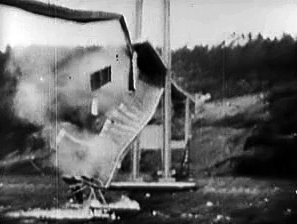Numb3rs 105: Structural Corruption
In this episode, a student who asked Charlie for help has
died. Though labeled as a suicide, Charlie insists that Don
investigate further.
Turbulence and flow
|
The flow of fluids is simultaneously among the most important
and most
complicated areas of engineering and mathematical physics. The
construction of airplanes obviously requires the understanding of air
flowing across the wings; it doesn't take much stretch of the
imagination to realize that the construction of high speed automobiles
and trains requires careful study of aerodynamics not just to reach
those high speeds but to prevent the vehicles from being torn to
pieces. That buildings and bridges needed to be carefully
constructed
with air flow in mind came as a shock to many. The Tacoma
Narrows Bridge, shown to the right, experienced a phenomena called resonance.
|

|
Imagine a young child is sitting on a swing. As is usually the case in homework problems from physics textbooks, you find that attached to the
child is a large spring. You stretch and relax the spring at various constant frequencies. As you vary the frequency
of this stretching
and relaxing, you notice that if the frequency is very high, the child
doesn't swing very high. The same thing happens when you push and
pull at very low frequency. As you increase the frequency from
low to high, you notice that the child starts swinging higher and
higher until at a certain frequency it peaks and then starts to fall
down again. The frequency in the middle is the maximum resonance
frequency. The oscillatory behavior of the child swinging (a
pendulum) and the oscillatory motion of you stretching and relaxing
interact with one another. At low and high frequencies, they work
against one another too much and the swing won't move very much.
At that maximum resonance frequency, though, the oscillation of the
rubber band is amplifying the motion of the swing as much as possible.
The same phenomena is found throughought nature. The famed
singing woman who can break a wine glass is theoretically
possible. When sound is directed toward the glass, the bulb of
the wine glass begins to stress and strain, though it looks like it is
just shaking. If the sound is at the correct frequency (and of
sufficient volume), then the strain from the oscillations will exceed
the elasticity of the glass and shatter it. The same volume which
shatters the glass will be completely useless at other
frequencies. In fact if the wind hits a poorly designed bridge
just right, the bridge will begin to twist to the point where it tears
itself apart. The problem Charlie is working on in this episode
is to determine whether the wind blowing against the side of the
building could cause enough strain to buckle the building.
Obviously the wind is not strong enough to physically push the building
over, but the with the fluid flow across the building, factors like
resonance can be huge.
The general equation which governs fluid flow is called the
Navier-Stokes equation. This equation is a non-linear partial
differential equation. As a result, it exhibits chaotic behavior
called turbulence. This means that even though two points are
relatively close to one another in position, the forces at each of
those two points could be vastly different. For example, in the
eye of a hurricane, there is almost no wind at all, and yet just
outside this small region, the winds are strong enough to tear the roof
off a house. When a plane takes off, the airflow immediately
below the plane is powerful enough to throw a car, and yet the wheels
of the plane are not destroyed. Chaos is a
property which results from non-linearity: solutions to non-linear
equations are extremely sensitive on initial conditions. This is
one reason why the weather is so hard to predict. Simply
approximating wind speed at a point is enough for the resulting weather
patterns to be completely different from reality over a very short
period of time. This is popularly called the Butterfly Effect - a
butterfly flapping its wings in Brazil could be the difference between
clear skies and tornados in Texas, to paraphrase the title of a talk
given by the physicist Lorenz. The Navier-Stokes equation is so
complicated that, despite being generally accepted as correct, no one
has found a long-time solution to it. Anyone who can find such a
solution (or prove none exists) will receive a $1,000,000 prize from
the Clay Institute.
Fluid flow is not just important in construction. Animal
flight is even more complicated than airplanes since the wings can move
in complicated ways. Why do large birds fly differently from
small insects? How does the bumblebee fly? Its flight was
not well-understood until the last few years. This glaring
inability to explain something so simple was one of the greatest
failures of science. Its wing size and number of flaps per minute
were not enough to explain how it could keep itself aloft. Its
unique style of flight is something noticed long ago. In fact, in
1934 a french entimologist claimed that the flight of the bumblebee was
aerodynamically impossible. However, in 2005 high speed digital
photography was able to show how the wings of the bee flap. As
mentioned in the episode, the way blood flows through the body is an
important factor in forensic medicine, let alone medicine proper.
